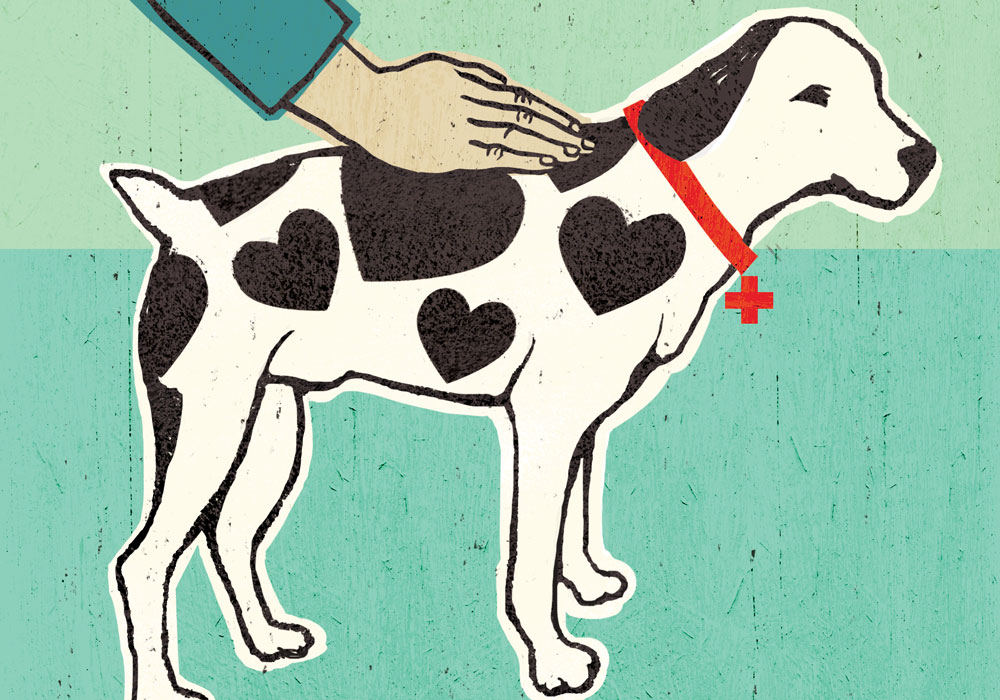Animal-facilitated therapy (AFT) programs have been shown to promote a healing environment and reduce certain psychological symptoms for patients with a variety of diagnoses, including cancer. Its use was even recommended by the founder of modern nursing, Florence Nightingale, who wrote about the benefits of animals in patient care and recovery: “a pet is often an excellent companion for the sick, for long chronic cases especially.”
In their article in the April 2018 issue of Clinical Journal of Oncology Nursing, Ginex et al. discussed the findings from their investigation of an AFT program’s effects on patients with cancer as well as healthcare staff on the unit.
Benefits of AFT
According to Ginex et al., previous studies of AFT in patients with diagnoses such as chronic pain, autism, depression, and mental illness have shown that the intervention improves symptoms of pain, fatigue, stress, mood, depression, and anxiety compared to controls or other traditional stress management techniques.
In patients with cancer specifically, AFT has reduced anxiety and depression and increased patients’ perception of their overall health. Patients in a hospice center also experienced decreased fear, anxiety, isolation, and loneliness, and they reported that the animals filled needs that the human staff could not, Ginex et al. reported.
Infection can be a concern when animals are involved, but Ginex et al. found studies demonstrating no change in infections, microorganisms, or contagious diseases when dogs were introduced in hospital settings. However, as a precaution, AFT should not be used in patients who are immunocompromised or receiving blood and marrow transplantation.
Although AFT is directed toward patients and its benefits are documented in that population, Ginex et al. (2018) found no research to date that has evaluated the benefit of AFT on staff members in an inpatient oncology setting.
AFT in Inpatient Oncology
Ginex et al. conducted a prospective pre-/post-test study with 100 patients following surgery and 41 staff members working on an inpatient surgical oncology unit. Fifty patients were assigned to the AFT intervention and 50 to the control group. In the staff group, 26 participants were nurses, 9 were ancillary staff, and 6 were technicians or unit assistants.
The hospital’s animal therapy program, called Caring Canines, delivered the intervention. Caring Canines ensures that the dogs are highly trained and carefully selected for temperament:
- Outgoing and friendly nature
- Active desire to interact with all kinds of people
- Confidence
- Ability to remain unphased by crowds, noises, and hospital-related equipment
Additionally, the dogs’ handlers were experienced in working with patients and families to determine the type and level of interaction they desired with the dogs.
The AFT program provided patients with one visit per day, four days per week, for a total of six weeks. Patients from both groups completed a baseline Patient Health Questionnaire-4 and a questionnaire to self-report symptoms, motivation to walk, and sense of well-being. Staff completed the Professional Quality-of-Life Scale, which measures compassion fatigue, secondary trauma, burnout, and compassion satisfaction.
How AFT Helps Patients and Providers
Patient responses fell into three themes:
- Offering a sense of happiness and hopefulness
- Providing a welcome distraction
- Giving motivation and energy needed during recovery
For quantitative measures, significant improvements were seen in levels of energy for both groups and anxiety for the control group. Qualitative findings showed that patients and staff viewed AFT positively, but accurately measuring those effects was difficult, which Ginex et al. noted that other previous studies have found too.
The researchers found two anecdotal patient benefits to AFT: (a) the importance of having experienced dog handlers who engaged with patients and families and provided a positive presence in tandem with the dogs, and (b) the positive effect on family and visitors. The second benefit even extended to remote family, such as minor children, with patients sending pictures of themselves with the dogs to help alleviate family members’ stress about patients’ well-being.
Staff responses also fell into three themes:
- Giving a sense of calming and comfort that lowered stress
- Offering a sense of happiness and hopefulness
- Providing a good distraction
According to Ginex et al., their study was the first “that assessed the impact of AFT on patients following cancer surgery and on clinical and nonclinical staff who work on a surgical oncology unit . . . [and to] assess the benefits of AFT during a period of consecutive days.”
For more information about AFT programs on an inpatient surgical unit, refer to the full article by Ginex et al.
This monthly feature offers readers a concise recap of full-length articles published in the Clinical Journal of Oncology Nursing (CJON) or Oncology Nursing Forum. This edition summarizes “Animal-Facilitated Therapy Program: Outcomes From Caring Canines, a Program for Patients and Staff on an Inpatient Surgical Oncology Unit,” by Pamela Ginex, EdD, RN, OCN®, Mary Montefusco, MSN, ACNP-BC, OCN®, BMTCN®, Glenn Zecco, RN, BSN, Nicole Trocchia Mattessich, MSN, FNP-BC, OCN®, Jacquelyn Burns, RN, MSN, NE-BC, Jane Hedal-Siegel, BFA, Jane Kopelman, CPDT-KA, and Kay See Tan, PhD, which was published in the April 2018 issue of CJON. Questions regarding the information presented in this article should be directed to the CJON editor at CJONEditor@ons.org. Photocopying of this article for educational purposes and group discussion is permitted.






